Have you ever noticed your espresso pouring unevenly, with some areas flowing faster than others? This frustrating phenomenon is called espresso channeling, and it’s one of the most common culprits behind sour, bitter, or underwhelming shots.
When water finds the path of least resistance through your coffee puck, it creates channels that extract some areas too much while leaving others barely touched. The result? Inconsistent flavor and diminished crema that can ruin your morning ritual. Understanding how to identify and prevent channeling will transform your home espresso game from disappointing to barista-quality with just a few simple adjustments to your technique.
What Is Espresso Channeling?
Espresso channeling occurs when water finds the path of least resistance through your coffee puck during extraction. This uneven water flow creates channels or pathways that allow water to rush through certain areas while bypassing others. Think of it like water flowing through a garden hose with several small holes – the water primarily escapes through these openings rather than reaching the end of the hose with consistent pressure.
When channeling happens, some parts of your coffee grounds get over-extracted, producing bitter compounds, while other areas remain under-extracted, contributing sour and underdeveloped flavors. The result is an unbalanced shot with compromised taste, body, and crema quality.
Visual signs of channeling include spurting, uneven flow from the portafilter spouts, and “dead spots” where no coffee emerges during extraction. You’ll often notice blonde streaks appearing early in the extraction process or coffee flowing much faster from one side of the portafilter than the other.
Experienced baristas like Rikki Manny can identify channeling problems by taste alone. “When I taste sharp acidity alongside harsh bitterness in the same shot, channeling is almost always the culprit,” Rikki explains. “It’s that distinctive clash of flavors that signals uneven extraction.”
Channeling significantly impacts extraction yield—the percentage of coffee solids dissolved in your final beverage. Properly extracted espresso typically yields between 18-22% dissolved solids, but channeling can create wildly inconsistent results even when using identical brewing parameters.
Signs Your Shot Is Channeling
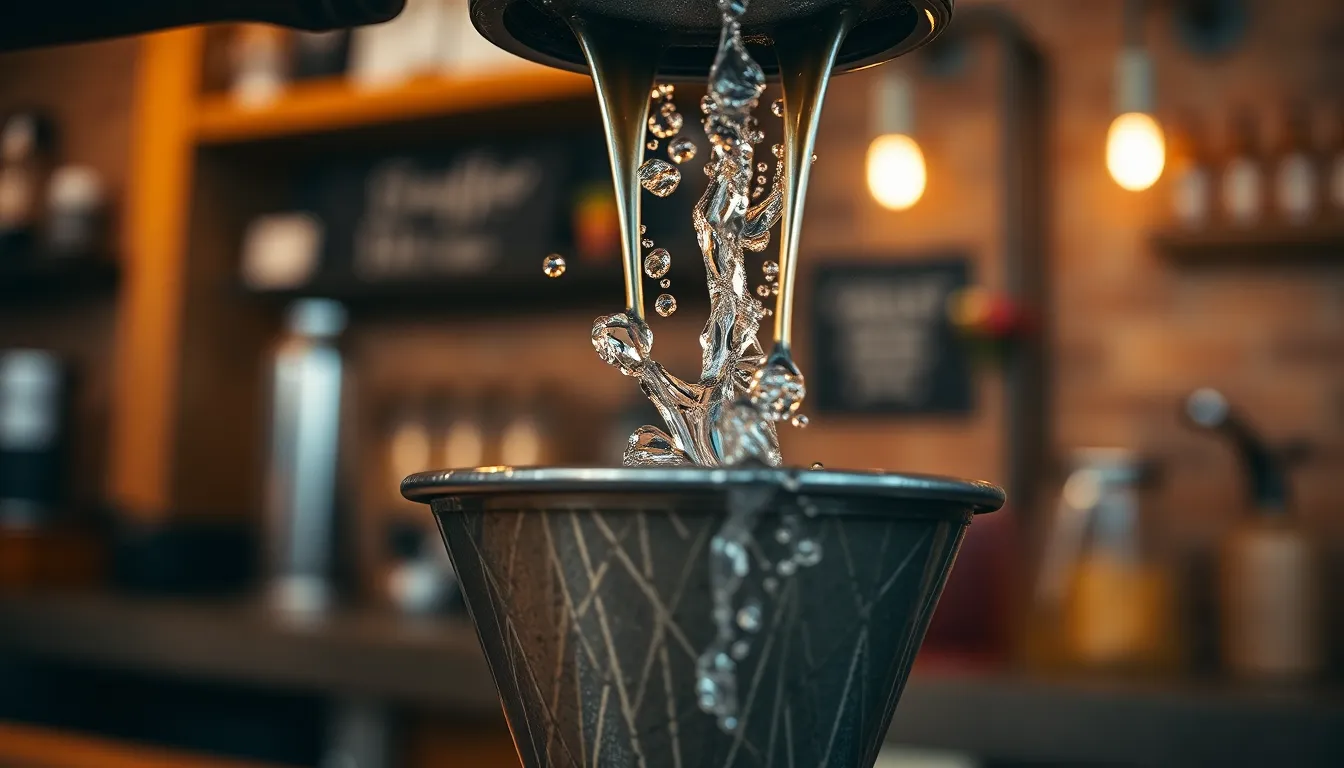
Detecting espresso channeling is crucial for diagnosing extraction problems and improving your coffee quality. Channeling manifests through distinct visual cues and telltale flavor characteristics that even novice home baristas can learn to identify.
Visual Indicators
A naked portafilter offers the clearest evidence of channeling through water behavior during extraction. You’ll notice spurting or shooting streams instead of a smooth, even flow from the bottom of the portafilter. These jets of liquid indicate water finding paths of least resistance through your coffee puck. After brewing, examine the used puck for obvious holes, cracks, or eroded areas—these physical markers show exactly where channeling occurred. The surface might appear uneven with noticeable gaps where water carved channels through the coffee bed.
Taste Issues
Channeled shots create a contradictory flavor profile that’s immediately recognizable. You’ll taste both acidic sourness and harsh bitterness simultaneously—a paradoxical combination resulting from some grounds being over-extracted while others remain under-extracted. The espresso often lacks body and feels watery or thin on the palate due to incomplete extraction across the puck. Astringency or a mouth-drying sensation frequently accompanies these shots, along with a shortened aftertaste that disappears quickly rather than lingering pleasantly. The expected flavor notes from your coffee beans will be muted or distorted, replaced by these extraction defects that mask the bean’s intended character.
Why Channeling Occurs in Espresso
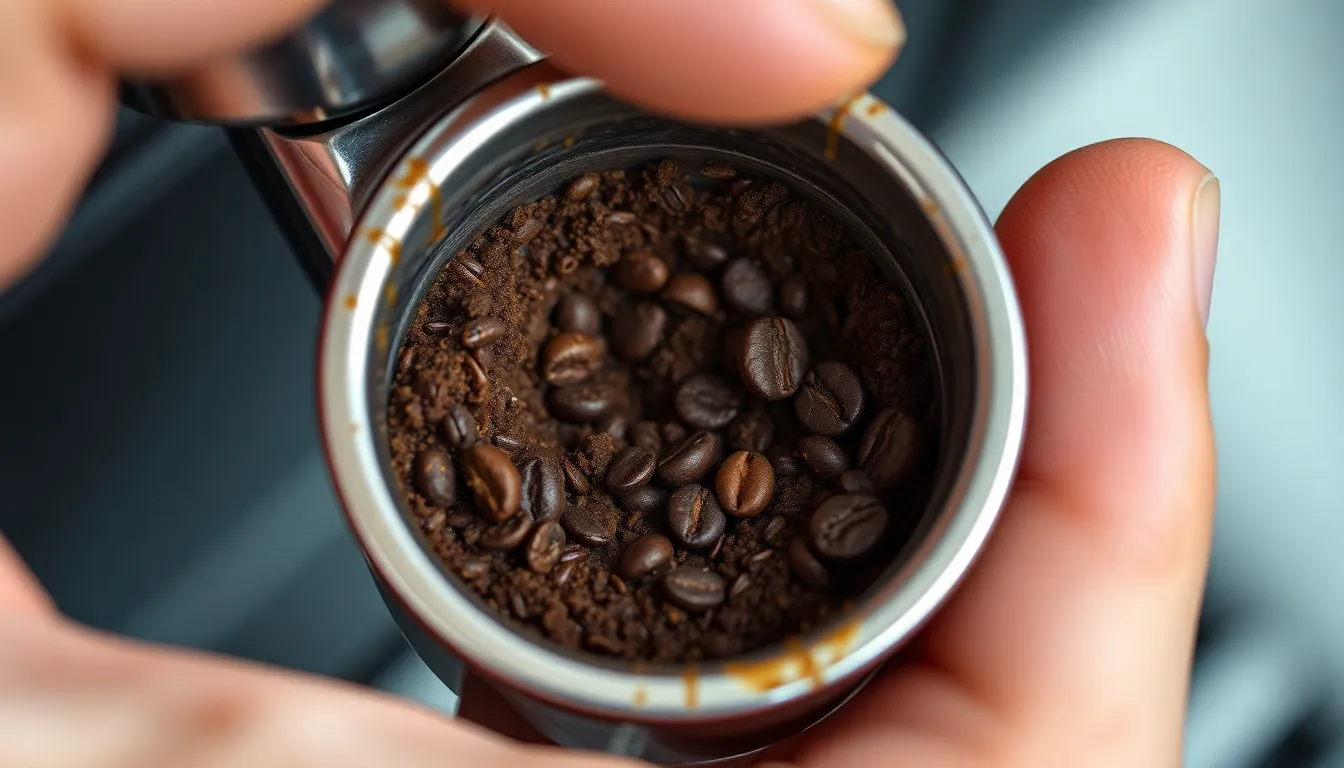
Espresso channeling happens when water takes the path of least resistance through your coffee puck, creating uneven extraction pathways. These channels force water to flow through exact areas while bypassing others, resulting in inconsistent flavor and reduced quality in your final shot. Let’s examine the three main culprits behind this common brewing problem.
Improper Distribution
Coffee grounds distributed unevenly in your portafilter create density variations that lead directly to channeling issues. When your coffee bed contains clumps or uneven spots, water naturally flows through less dense areas first, creating channels that overextract those regions while leaving other parts virtually untouched. Using distribution tools like WDT (Weiss Distribution Technique) tools helps break up clumps and create an even coffee bed before tamping. A level coffee surface before tamping significantly reduces the risk of channeling and improves extraction uniformity across the entire puck.
Inadequate Tamping
Your tamping technique plays a crucial role in preventing channeling during extraction. Applying uneven pressure creates low-density zones where water rushes through too quickly, bypassing properly compacted areas. Surprisingly, pressing too hard can be equally problematic – excessive tamping compresses the puck so tightly that water struggles to penetrate evenly and forces its way through any weak points it finds. Consistent, level tamping with moderate pressure (about 30 pounds) creates optimal resistance throughout the coffee bed and promotes even extraction from edge to edge.
Grind Size Problems
Grind size dramatically affects how water flows through your coffee puck during extraction. Coffee ground too coarsely creates gaps between particles where water can easily form channels without extracting properly. Conversely, extremely fine grinds increase resistance to the point where pressure builds excessively, forcing water to break through weak spots in the puck rather than flowing evenly. Dialing in the perfect grind requires finding the balance where water meets enough resistance to extract properly without becoming so restricted that it creates channels. Making small, incremental adjustments to your grinder settings often resolves persistent channeling issues when distribution and tamping techniques are already solid.
How Channeling Affects Your Espresso Quality
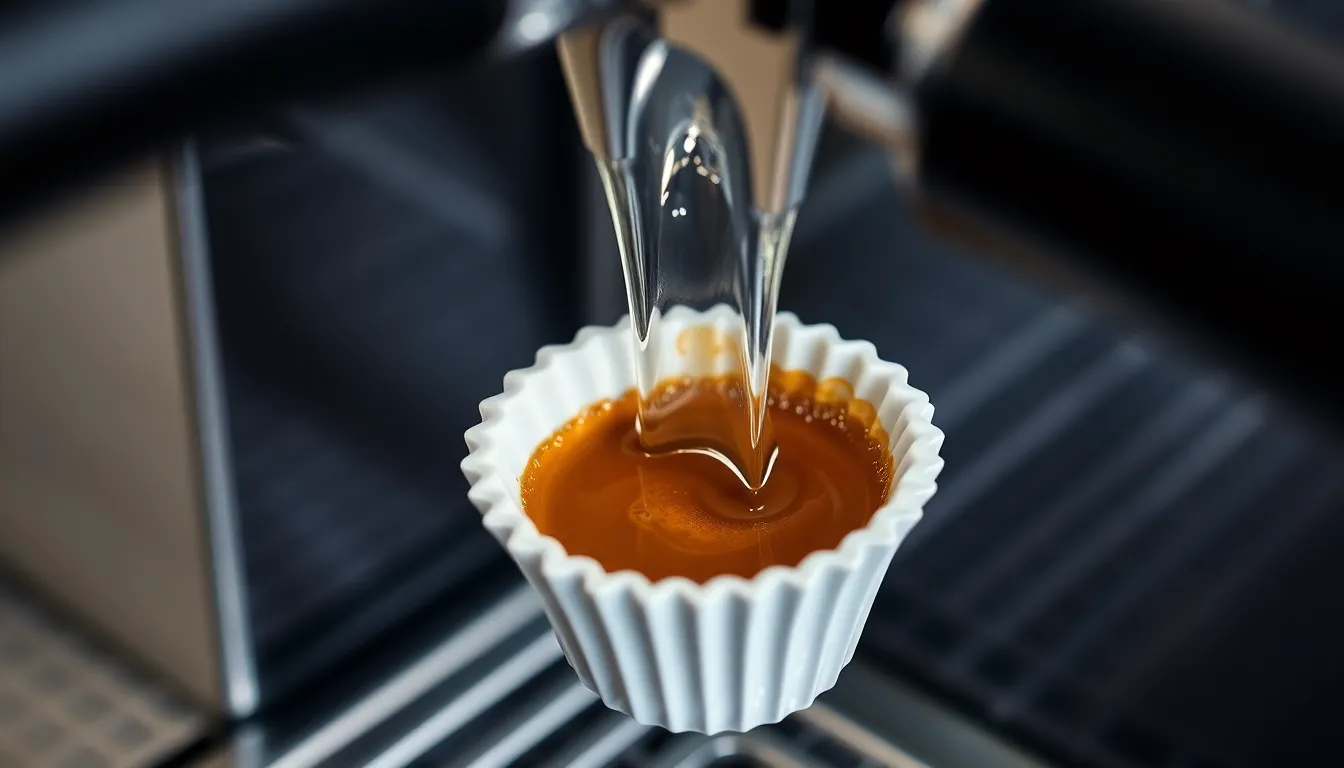
Espresso channeling directly impacts the quality of your shots by disrupting the fundamental extraction process. When water finds paths of least resistance through your coffee puck, it creates a cascade of quality issues that compromise your espresso experience.
Extraction Imbalance
Extraction imbalance occurs when water flows unevenly through the coffee puck, creating over-extracted and under-extracted areas simultaneously. Some parts of your coffee puck get overly saturated with water, producing bitter compounds and harsh flavors. Other areas receive minimal contact with water, resulting in sour, acidic notes due to under-extraction. This dual extraction problem wastes important portions of your coffee grounds, as sections remain virtually untouched while others get excessively processed. The efficiency of your extraction drops considerably when channeling occurs, preventing full flavor development from your carefully selected beans.
Flavor Inconsistency
Channeling creates espresso shots with conflicting and contradictory flavor profiles that lack harmony. Your espresso might taste simultaneously sour and bitter—an unpleasant combination that indicates serious extraction problems. These competing flavors create a disjointed tasting experience rather than the smooth, balanced profile you’re aiming for. Shot-to-shot consistency becomes nearly impossible to achieve with channeling issues, as the random nature of channel formation means each extraction follows a different path through the coffee puck. The distinctive characteristics of your coffee beans get lost in this extraction chaos, undermining the nuanced flavors that quality espresso should deliver.
Channeling also affects your espresso’s visual and textural qualities. Crema formation suffers significantly, becoming thin and less dense when channeling occurs. During extraction, you’ll notice sputtering water from the portafilter and uneven streaming—clear visual indicators of channeling problems. Shot timing becomes unpredictable, with extraction speeds varying as water finds different pathways through the coffee, further affecting temperature consistency crucial for proper extraction.
Equipment That Can Reduce Channeling
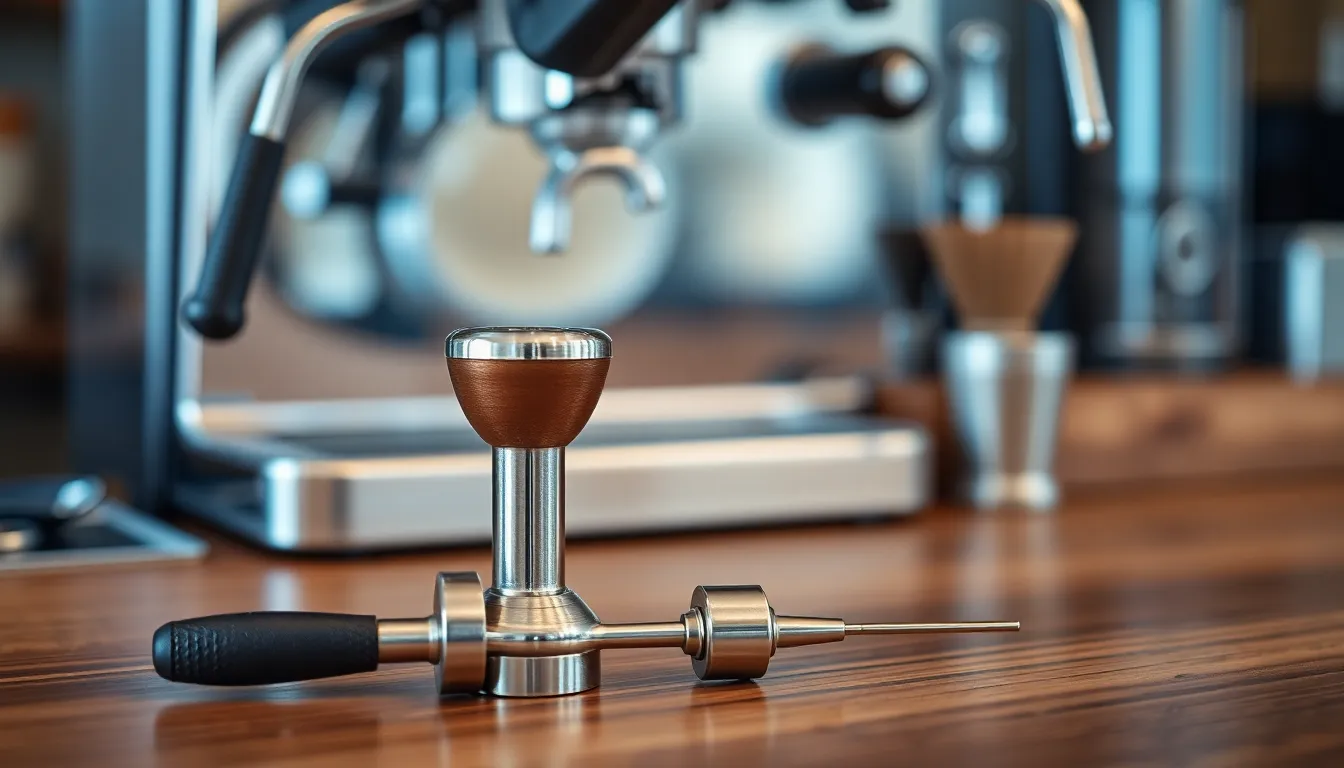
The right equipment makes a important difference in preventing espresso channeling. Specialized tools help create even coffee beds and consistent tamping pressure, addressing the core causes of channeling issues before extraction begins.
Distribution Tools
Distribution tools ensure coffee grounds spread evenly throughout the portafilter basket before tamping. These purpose-built accessories create a level coffee bed with uniform density, eliminating the low-resistance areas where channels commonly form. Popular distribution tools include distribution wands that allow you to stir and evenly spread grounds, and leveling tools (often called distribution tools) that create a perfectly flat surface. By incorporating a distribution tool into your workflow, you’ll eliminate density variations across the coffee puck that lead to preferential water flow through less dense areas during extraction.
Precision Tampers
Precision tampers apply consistent, even pressure across the entire coffee bed, creating uniform density throughout the puck. These specialized tampers often feature calibrated mechanisms that ensure you apply identical pressure with each tamp, preventing the uneven compression that creates weak spots and channeling. Many precision tampers come weighted or feature ergonomic designs that naturally guide you toward applying pressure straight down rather than at angles. The flat, level surface created by a precision tamper forces water to travel evenly through the entire coffee bed rather than finding easier pathways through irregularly tamped areas.
Step-by-Step Prevention Techniques
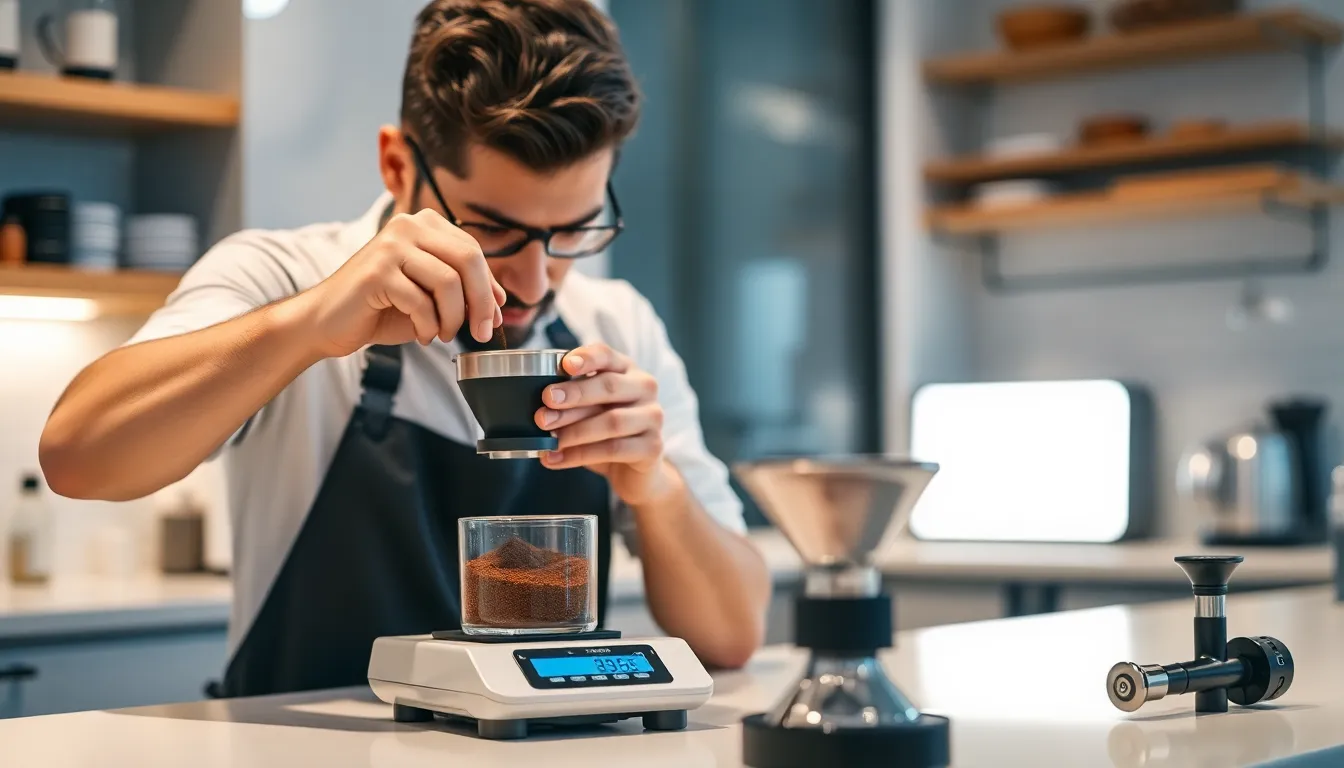
Preventing espresso channeling requires a methodical approach that addresses several key areas of your coffee preparation process. These techniques target the most common causes of channeling and help create a more uniform extraction for better-tasting espresso.
Proper Dose Measurement
Accurate dosing forms the foundation of channel-free extraction. Using the right amount of coffee prevents both underdosing and overdosing, which create weak spots or cracks in the puck where water can channel through. Begin by measuring your coffee precisely with a digital scale accurate to 0.1g for consistency across shots. Distribute your grounds evenly throughout the portafilter basket, eliminating any gaps or buildup that might create paths of least resistance. Even distribution at this stage sets up the rest of your workflow for success and dramatically reduces the likelihood of channeling.
WDT Method
The Weiss Distribution Technique (WDT) breaks up clumps and creates homogeneous coffee beds for even extraction. Using a fine needle tool or modified paperclip, gently stir the grounds in your portafilter with small circular motions, working from the center outward. This motion eliminates coffee clumps that form natural channels and ensures uniform density throughout the puck. Coffee particles naturally cluster together due to static electricity and moisture, and the WDT effectively disrupts these problematic formations. Many home baristas report immediate improvements in shot consistency after implementing this simple yet effective technique in their espresso preparation routine.
Tamping Best Practices
Consistent tamping technique directly influences how water flows through your coffee puck. Apply even pressure across the entire coffee bed, keeping your tamper level to prevent creating low-density areas where channeling occurs. Press firmly enough to properly compact the coffee—around 30 pounds of pressure provides sufficient compression without being excessive. Avoid tapping the side of the portafilter after tamping, as this creates cracks along the edges where the puck meets the basket. Perform a single, deliberate tamping motion rather than multiple presses, which can create layering that promotes channeling. After tamping, examine your puck for evenness and use a distribution tool beforehand to improve uniformity. A bottomless portafilter helps identify tamping issues by showing exactly where channeling occurs during extraction, making it easier to refine your technique over time.
Diagnosing and Fixing Existing Channeling Issues
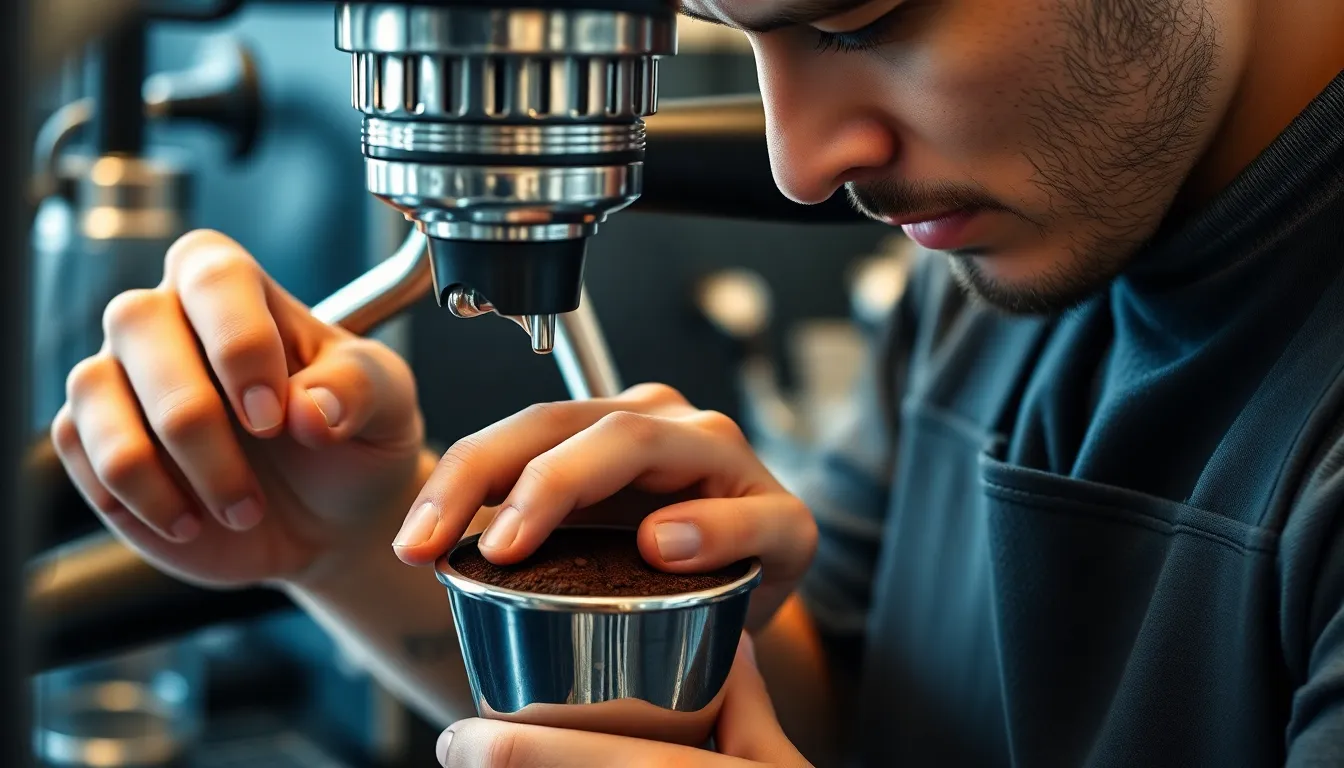
Identifying Channeling Through Visual Inspection
Visual clues offer immediate feedback about channeling issues in your espresso. When using a naked portafilter, channeling appears as water spurting or shooting from exact points in the coffee puck rather than flowing uniformly. These irregular streams indicate that water has found paths of least resistance through your coffee bed. Examining the used puck after extraction also reveals valuable information—look for holes, cracks, or uneven wetness that signal water’s uneven journey through the grounds.
Recognizing Channeling Through Taste
Taste provides unmistakable evidence of channeling problems in your espresso. Shots affected by channeling typically exhibit contradictory flavor characteristics—simultaneously acidic and bitter, creating an unpleasant taste experience. The resulting espresso often tastes watery or astringent due to the combination of over-extracted and under-extracted areas within the same puck. This distinctive flavor profile occurs because grounds near channels get over-extracted (producing bitterness), while areas away from channels remain under-extracted (contributing sourness).
Effective Answers for Distribution Problems
Improving coffee distribution forms the foundation of channeling prevention. Employ these techniques to ensure even distribution:
- Use the Weiss Distribution Technique (WDT) with a fine needle tool to break up clumps
- Tap the portafilter gently to settle grounds before tamping
- Use specialized distribution tools that create level coffee beds
- Remove excess grounds with a straight-edge tool for a consistent dose
Even distribution eliminates density variations that lead to channeling, creating a uniform resistance path for water throughout the entire puck.
Perfecting Your Tamping Technique
Tamping consistency dramatically impacts channel formation in espresso extraction. Apply firm, even pressure when tamping to create uniform puck density and avoid weak spots. Position the tamper flat against the coffee surface and press straight down with 30-40 pounds of pressure. Avoid common mistakes like angled tamping or inconsistent pressure that create density variations. Proper tamping seals potential gaps and creates the uniform resistance needed for even extraction.
Optimizing Grind Size and Dose
Grind adjustment often resolves persistent channeling issues in espresso preparation. Ensure your grinder produces consistent particle sizes without excessive fines that can clog flow paths. Adjust your grind size incrementally if shots pull too quickly (indicating potential channeling), finding the sweet spot that allows proper resistance without blocking flow. Pair appropriate grind size with the optimal coffee dose for your basket—using too little coffee creates shallow pucks prone to channeling, while overfilling can cause fractures during extraction.
Maintaining Your Equipment
Equipment maintenance plays a crucial role in preventing chronic channeling problems. Clean your portafilter baskets regularly to remove coffee oils and residue that can disrupt water flow. Check that your machine’s brewing pressure stays within the appropriate range—excessive pressure can fracture the puck and create channels. Replace worn gaskets that might allow water to bypass the puck edges. Regular backflushing and descaling maintain even water distribution through the group head, eliminating another potential source of channeling.
Conclusion
Mastering espresso channeling is a game-changer for your home brewing journey. By recognizing the telltale signs and implementing proper distribution techniques you’ll transform inconsistent shots into balanced extractions with remarkable flavor clarity.
Remember that precision tools are investments in quality rather than mere accessories. Your attention to dose measurement tamping technique and grind size adjustments will pay dividends in cup quality.
The path to exceptional espresso isn’t about expensive equipment but rather understanding and controlling the extraction process. With these channeling prevention strategies in your arsenal you’re now equipped to diagnose problems quickly and make the necessary adjustments for consistently delicious results.
Your perfect shot awaits – uniform extraction free from channeling and full of the complex flavors your coffee beans promise.
Frequently Asked Questions
What is espresso channeling?
Espresso channeling occurs when water flows unevenly through the coffee puck during extraction. Instead of passing uniformly through the grounds, water creates channels or paths of least resistance, resulting in some areas being over-extracted (bitter) while others remain under-extracted (sour). This leads to inconsistent flavor and lower quality espresso.
How can I identify channeling in my espresso?
Look for visual signs like spurting or uneven flow from the portafilter, especially with a naked portafilter. Examine the used puck for holes or cracks. Taste-wise, channeled shots often have contradictory flavors—simultaneously sour and bitter—with weak mouthfeel and muted flavor notes. Shot timing may also be inconsistent or faster than expected.
What causes espresso channeling?
Three main factors cause channeling: 1) Improper distribution of coffee grounds creating density variations, 2) Inadequate or uneven tamping that creates weak spots in the puck, and 3) Incorrect grind size (too fine or too coarse). Additional factors include using too much coffee, equipment issues, or poor puck preparation technique.
How does channeling affect espresso quality?
Channeling creates extraction imbalance with both over-extracted and under-extracted areas in the same shot. This results in conflicting flavors (sour and bitter simultaneously), thin crema, inconsistent shot timing, and overall reduced extraction efficiency. The nuanced flavors that quality espresso should deliver are undermined, wasting coffee potential.
What tools can help prevent channeling?
Distribution tools like WDT tools (thin needles in a holder) help spread grounds evenly throughout the portafilter. Precision tampers ensure consistent, level pressure across the entire coffee bed. Calibrated tampers can help maintain consistent pressure between shots. A quality grinder producing uniform particle size is also essential for preventing channeling.
How can I fix channeling issues?
Start by measuring your dose precisely with a digital scale. Use the Weiss Distribution Technique (WDT) with thin needles to break up clumps and distribute grounds evenly. Apply consistent, level tamping pressure (about 30 pounds). Adjust your grind size appropriately—not too fine or coarse. Keep your equipment clean and properly maintained, especially shower screens and baskets.
Does grind size affect channeling?
Yes, significantly. Too coarse a grind creates gaps between particles where water can flow too quickly, causing channeling. Too fine a grind can increase resistance to the point where water forces its way through weak spots in the puck. Finding the optimal grind size for your specific coffee and equipment is crucial for preventing channeling.
Can my equipment cause channeling?
Absolutely. Poor quality or dirty shower screens can distribute water unevenly. Worn or uneven baskets can create irregular extraction patterns. Inconsistent machine pressure or temperature can also contribute to channeling. Regular maintenance, including backflushing and descaling, helps ensure even water distribution and prevent channeling issues.














